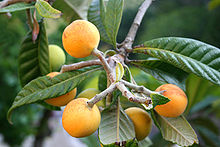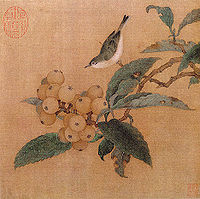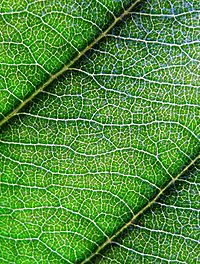- Loquat
-
This article is about a species of flowering plants called Medlar. For other uses, see Medlar.
Loquat
Eriobotrya japonica
Loquat leaves and fruits. Scientific classification Kingdom: Plantae (unranked): Angiosperms (unranked): Eudicots (unranked): Rosids Order: Rosales Family: Rosaceae Genus: Eriobotrya Species: E. japonica Binomial name Eriobotrya japonica
(Thunb.) Lindl.Synonyms Mespilus japonica
Photinia japonicaThe loquat (
 /ˈloʊkwæt/), Eriobotrya japonica, is a fruit tree in the family Rosaceae, indigenous to southeastern China. It was formerly thought to be closely related to the genus Mespilus, and is still sometimes known as the Japanese medlar. It is also known as Japanese plum and as Chinese plum.
/ˈloʊkwæt/), Eriobotrya japonica, is a fruit tree in the family Rosaceae, indigenous to southeastern China. It was formerly thought to be closely related to the genus Mespilus, and is still sometimes known as the Japanese medlar. It is also known as Japanese plum and as Chinese plum.Contents
Description
Eriobotrya japonica is an evergreen large shrub or small tree, with a rounded crown, short trunk and woolly new twigs. The tree can grow to 5–10 metres (16–33 ft) tall, but is often smaller, about 3–4 metres (9.8–13 ft).
The leaves are alternate, simple, 10–25 cm long, dark green, tough and leathery in texture, with a serrated margin, and densely velvety-hairy below with thick yellow-brown pubescence; the young leaves are also densely pubescent above, but this soon rubs off.
Fruit
Loquats are unusual among fruit trees in that the flowers appear in the autumn or early winter, and the fruits are ripe in late winter or early spring. The flowers are 2 cm diameter, white, with five petals, and produced in stiff panicles of three to ten flowers. The flowers have a sweet, heady aroma that can be smelled from a distance.
Loquat fruits, growing in clusters, are oval, rounded or pear-shaped, 3–5 cm long, with a smooth or downy, yellow or orange, sometimes red-blushed skin. The succulent, tangy flesh is white, yellow or orange and sweet to subacid or acid, depending on the cultivar. Each fruit contains five ovules, of which one to five mature into large brown seeds. The skin, though thin, can be peeled off manually if the fruit is ripe.
The fruits are the sweetest when soft and orange. The flavor is a mix of peach, citrus and mild mango.
History
 Loquats and a Mountain Bird, by an anonymous Chinese artist of the Southern Song Dynasty (1127–1279).
Loquats and a Mountain Bird, by an anonymous Chinese artist of the Southern Song Dynasty (1127–1279).
The loquat is originally from southeastern China. It was introduced into Japan and became naturalised there in very early times, and has been cultivated there for over 1,000 years. It has also become naturalised in India, the whole Mediterranean Basin, Pakistan and many other areas. Chinese immigrants are presumed to have carried the loquat to Hawaii.
The loquat was often mentioned in ancient Chinese literature, such as the poems of Li Bai. In Portuguese literature, it is mentioned since before the Age of Discovery.[1]
Uses
Culinary
The loquat is comparable with its distant relative, the apple, in many aspects, with a high sugar, acid and pectin content. It is eaten as a fresh fruit and mixes well with other fruits in fresh fruit salads or fruit cups. Firm, slightly immature fruits are best for making pies or tarts. The fruits are also commonly used to make jam, jelly, and chutney, and are often served poached in light syrup.
In Japan, it is eaten fresh or sometimes canned because the flesh is sweet. However, the waste ratio is 30% or more, due to the size of the seed. Among other things, it is processed to confectionery including jellies and the jam.
Loquats can also be used to make light wine. It is fermented into a fruit wine, sometimes using just the crystal sugar and white liquor. Lemon or lemon zest is often paired with the wine because the fruit has very low acidity. Aficionados also enjoy a sake made exclusively from the seed, which has an aroma much like apricot kernel. Due to the presence of cyanogenic glycosides, bulk consumption may pose a risk of cyanide poisonings.
- Nutrition
The loquat is low in saturated fat and sodium, and is high in vitamin A, dietary fiber, potassium, and manganese.[2]
Like most related plants, the seeds (pips) and young leaves of the plant are slightly poisonous, containing small amounts of cyanogenic glycosides (including amygdalin) which release cyanide when digested, though the low concentration and bitter flavour normally prevents enough being eaten to cause harm.
 Loquat in flower. This is a cultivar intended for home-growing, where the flowers open gradually resulting in fruit also ripening gradually.
Loquat in flower. This is a cultivar intended for home-growing, where the flowers open gradually resulting in fruit also ripening gradually.
Medicinal
Loquat syrup is used in Chinese medicine for soothing the throat and is a popular ingredient for cough drops.[citation needed] The leaves, combined with other ingredients and known as pipa gao (枇杷膏; pinyin: pípágāo; literally "loquat paste"), it acts as a demulcent and an expectorant, as well as to soothe the digestive and respiratory systems.[citation needed]
Eaten in quantity, loquats have a gentle but noticeable sedative effect, with effects lasting up to 24 hours.[3]
Cultivation
The Loquat is easy to grow in subtropical to mild temperate climates where it is often grown as an ornamental tree, and second for its delicious fruit. The boldly textured foliage adds a tropical look to gardens, contrasting well with many other plants.
There are many named cultivars, with orange or white flesh.[4] Some cultivars are intended for home-growing, where the flowers open gradually, and thus the fruit also ripens gradually, compared to the commercially grown species where the flowers open almost simultaneously, and the whole tree's fruit also ripens together.
Japan is the leading producer of loquats followed by Israel and then Brazil.[5]
Etymology
The name loquat derives from lou4 gwat1, the Cantonese pronunciation of its old classical Chinese name (simplified Chinese: 芦橘; traditional Chinese: 蘆橘; pinyin: lújú, literally "reed orange").
See also
- Kumquat (Although Kumquats are not related botanically to Loquats, the two names share an origin in their old Chinese names.)
- Coppertone loquat, a hybrid of Eriobotrya deflexa (synonym: Photinia deflexa) and Rhaphiolepis indica
References
- ^ See the Dicionário Houaiss, entries for "nêspera" (loquat) and "nespereira" (loquat tree).
- ^ Wolfram Alpha entry
- ^ pfaf.org database
- ^ Description from California Rare Fruit Growers, Inc.
- ^ Loquat factsheet 1997 California Rare Fruit Growers, Inc.
- Botanical and Horticultural Information on the Loquat (Traditional Chinese).
External links
Categories:- Maleae
- Fruits originating in Asia
- Flora of China
- Accessory fruit
- Tropical fruit
- Medicinal plants
- Garden plants of Asia
- Ornamental trees
Wikimedia Foundation. 2010.


